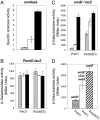Small RNA as global regulator of carbon catabolite repression in Pseudomonas aeruginosa
- PMID: 20080802
- PMCID: PMC2799872
- DOI: 10.1073/pnas.0910308106
Small RNA as global regulator of carbon catabolite repression in Pseudomonas aeruginosa
Abstract
In the metabolically versatile bacterium Pseudomonas aeruginosa, the RNA-binding protein Crc is involved in catabolite repression of a range of degradative genes, such as amiE (encoding aliphatic amidase). We found that a CA-rich sequence (termed CA motif) in the amiE translation initiation region was important for Crc binding. The small RNA CrcZ (407 nt) containing 5 CA motifs was able to bind the Crc protein with high affinity and to remove it from amiE mRNA in vitro. Overexpression of crcZ relieved catabolite repression in vivo, whereas a crcZ mutation pleiotropically prevented the utilization of several carbon sources. The sigma factor RpoN and the CbrA/CbrB two-component system, which is known to maintain a healthy carbon-nitrogen balance, were necessary for crcZ expression. During growth on succinate, a preferred carbon source, CrcZ expression was low, resulting in catabolite repression of amiE and other genes under Crc control. By contrast, during growth on mannitol, a poor carbon source, elevated CrcZ levels correlated with relief of catabolite repression. During growth on glucose, an intermediate carbon source, CrcZ levels and amiE expression were intermediate between those observed in succinate and mannitol media. Thus, the CbrA-CbrB-CrcZ-Crc system allows the bacterium to adapt differentially to various carbon sources. This cascade also regulated the expression of the xylS (benR) gene, which encodes a transcriptional regulator involved in benzoate degradation, in an analogous way, confirming this cascade's global role.
Conflict of interest statement
The authors declare no conflict of interest.
Figures







Similar articles
-
Two small RNAs, CrcY and CrcZ, act in concert to sequester the Crc global regulator in Pseudomonas putida, modulating catabolite repression.Mol Microbiol. 2012 Jan;83(1):24-40. doi: 10.1111/j.1365-2958.2011.07912.x. Epub 2011 Nov 20. Mol Microbiol. 2012. PMID: 22053874
-
Regulation of Hfq by the RNA CrcZ in Pseudomonas aeruginosa carbon catabolite repression.PLoS Genet. 2014 Jun 19;10(6):e1004440. doi: 10.1371/journal.pgen.1004440. eCollection 2014 Jun. PLoS Genet. 2014. PMID: 24945892 Free PMC article.
-
Promoter recognition and activation by the global response regulator CbrB in Pseudomonas aeruginosa.J Bacteriol. 2011 Jun;193(11):2784-92. doi: 10.1128/JB.00164-11. Epub 2011 Apr 8. J Bacteriol. 2011. PMID: 21478360 Free PMC article.
-
Rewiring the functional complexity between Crc, Hfq and sRNAs to regulate carbon catabolite repression in Pseudomonas.World J Microbiol Biotechnol. 2019 Aug 26;35(9):140. doi: 10.1007/s11274-019-2717-7. World J Microbiol Biotechnol. 2019. PMID: 31451938 Review.
-
Small RNAs as regulators of primary and secondary metabolism in Pseudomonas species.Appl Microbiol Biotechnol. 2011 Jul;91(1):63-79. doi: 10.1007/s00253-011-3332-1. Epub 2011 May 24. Appl Microbiol Biotechnol. 2011. PMID: 21607656 Review.
Cited by
-
Preliminary study on the effect of catabolite repression gene knockout on p-nitrophenol degradation in Pseudomonas putida DLL-E4.PLoS One. 2022 Dec 2;17(12):e0278503. doi: 10.1371/journal.pone.0278503. eCollection 2022. PLoS One. 2022. PMID: 36459525 Free PMC article.
-
The Crc global regulator inhibits the Pseudomonas putida pWW0 toluene/xylene assimilation pathway by repressing the translation of regulatory and structural genes.J Biol Chem. 2010 Aug 6;285(32):24412-9. doi: 10.1074/jbc.M110.126615. Epub 2010 Jun 7. J Biol Chem. 2010. PMID: 20529863 Free PMC article.
-
Quorum sensing in Pseudomonas aeruginosa mediated by RhlR is regulated by a small RNA PhrD.Sci Rep. 2019 Jan 23;9(1):432. doi: 10.1038/s41598-018-36488-9. Sci Rep. 2019. PMID: 30674910 Free PMC article.
-
The ColRS system is essential for the hunger response of glucose-growing Pseudomonas putida.BMC Microbiol. 2011 Jul 26;11:170. doi: 10.1186/1471-2180-11-170. BMC Microbiol. 2011. PMID: 21791104 Free PMC article.
-
Unraveling the role of the CbrA histidine kinase in the signal transduction of the CbrAB two-component system in Pseudomonas putida.Sci Rep. 2019 Jun 24;9(1):9110. doi: 10.1038/s41598-019-45554-9. Sci Rep. 2019. PMID: 31235731 Free PMC article.
References
-
- Monod J. Recherches sur la croissance des cultures bactériennes. Paris: Hermann; 1942.
-
- Ullmann A. Catabolite repression: A story without end. Res Microbiol. 1996;147:455–458. - PubMed
-
- Görke B, Stülke J. Carbon catabolite repression in bacteria: Many ways to make the most out of nutrients. Nat Rev Microbiol. 2008;6:613–624. - PubMed
-
- Smyth PF, Clarke PH. Catabolite repression of Pseudomonas aeruginosa amidase: The effect of carbon source on amidase synthesis. J Gen Microbiol. 1975;90:81–90. - PubMed
Publication types
MeSH terms
Substances
LinkOut - more resources
Full Text Sources
Other Literature Sources
Molecular Biology Databases
Research Materials

